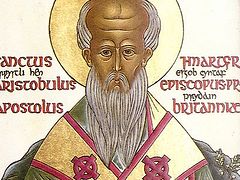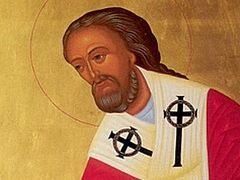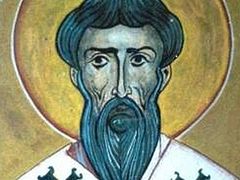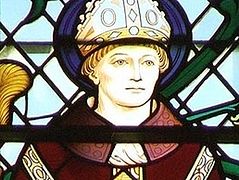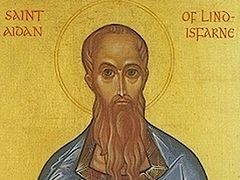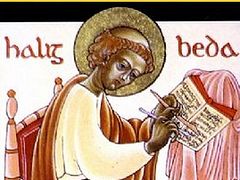There are a number of early saints of England whose spirit of love, humility and kindness was not erased by the centuries of Protestantism and secularism. St. John of Beverley, whom our great authority, the Venerable Bede of Jarrow, referred to as a “wonderworker”, is one of them.
St. John was born at Harpham in Yorkshire in the kingdom of Northumbria (the north of England) to a noble family in the mid-seventh century. As a young man he obtained an excellent education, studying at the most famous school and seminary in Canterbury, most probably under the direction of the holy archbishop Theodore and the holy abbot Hadrian. There he learned Greek and Latin, mathematics, astronomy and other sciences, Church music, art, church poetry and medicine. Knowledge of medicine later helped him cure many people of diseases. However, secular life with all its temptations did not attract the young man. Instead St. John was tonsured a monk and returned to his native Yorkshire. He joined the double monastery of Whitby (now in North Yorkshire at the mouth of the River Esk) under the holy Abbess Hilda, where he learned the spiritual life. The young monk spent much time in the large monastery library and in due course became noted as a commentator on the Holy Scriptures and a highly learned man.
 Stained glass depicting St. John of Beverley inside St. John Lee Church in Acomb, Northumb. (kindly provided by the rector of St. John Lee Church)
Stained glass depicting St. John of Beverley inside St. John Lee Church in Acomb, Northumb. (kindly provided by the rector of St. John Lee Church) In 705, after the repose of St. Bosa of York, St. John became Bishop of York. He served in that see for thirteen years as a most active and zealous archpastor. He consecrated churches, visited monasteries and convents, and inspired love in people’s hearts by his numerous miracles of healing, care for the sick, the disabled, cripples, the destitute, and his inexhaustible compassion to all. Herebald, his disciple, who later became an abbot, related that the holy bishop always preached much during his long travels through his large diocese, instructed students in church singing and in time became a patron of musicians as well.
St. John was always concerned about the education and training of young people; thus he founded schools and taught young adults various arts. Here are a few examples of his miracles (many were attested by St. Bede). Once Herebald, mentioned above, fell off his horse and was badly hurt, but through the holy hierarch’s intercessions was instantly healed. One abbess implored the saint to pray for her dying young nun who was suffering from tormenting pain in her arm. St. John came up to the girl, blessed her and she immediately recovered. One wealthy man besought the man of God to visit his house, for his wife was gravely ill. St. John ordered that the water he had just blessed be given to the woman as soon as possible – and she was cured in the same minute. Another man, named Addi, asked St. John to help his servant who was lying on his deathbed – the bishop offered up his fervent prayers and the servant at once got up absolutely healthy. One evening a deacon looked inside a chapel where St. John was praying and saw him surrounded by a supernatural unearthly light with a white dove above him (a symbol of the Holy Spirit).
 Stained glass window depicting St. John of Beverley inside St. John Lee Church in Acomb, Northumb. (kindly provided by the rector of St. John Lee Church)
Stained glass window depicting St. John of Beverley inside St. John Lee Church in Acomb, Northumb. (kindly provided by the rector of St. John Lee Church) The Venerable Bede wrote a detailed account of his life, later in the same century Alcuin (c. 735-804; an English scholar and later adviser at the Carolingian court) described his miracles, and a late Life was composed by the Flemish hagiographer Folcard in the eleventh century. The Bollandist Society in its fundamental work Acta Sanctorum (most of which was written between 1643 and 1794 in fifty-three volumes) gave considerable attention to St. John of Beverley and his miracles.
Among the disciples of St. John we can mention several other saints such as St. Bercthun (also Brithun, Bertinus; † 733, feast: May 15/28), the first abbot of Beverley (as St. John was never its abbot, and lived there as a recluse) who provide most of the information St. Bede had on Beverley Monastery; St. Winewald († c. 751; feast: April 27/May 10), second abbot of Beverley; and St. Wilfrid the Younger2 († 744 or 745; feast: April 29/May 12), St. John’s successor as bishop of York. It is certain that St. John was the author of a number of written works in Latin (homilies, epistles), none of which are extant.
The veneration of St. John began right after his death, and many cases of miracles were recorded. His name can be found in many early English calendars. In 1037 his relics were translated by Alfric, archbishop of York. St. John loved Beverley dearly and in effect he was the founder of this town. Down the centuries the faithful called him not “St. John of York” (which would have been logical) but “St. John of Beverley”.
Throughout the Middle Ages John remained one of the greatest saints of northern England and, from approximately the year 1000, as one of the national protectors. Many criminals who managed to escape justice had the right to go to Beverley and find refuge there for a month or more. There are many examples of St. John’s protection over the monks and townsfolk of Beverly from various troubles. Kings prayed to John before important battles and asked for his protection. Thus, Edward I (ruled 1272-1307) donated money to create the saint’s new shrine and the new translation took place in 1307, exactly the year this king died. Also, King Henry V (ruled 1413-1422), who ascribed his glorious victory of Agincourt in 1415 on his translation feast to the saint’s intercession, ordered St. John’s festival to be kept solemnly in all the churches of the country and made him one of the royal family’s patrons. In the late middle ages there existed St. John’s Banner, or St. John’s Standard, which was used in battles by such kings as Edward I (more than once), Edward II (ruled 1307-1327), Edward III (ruled 1327-1377), and Henry IV (ruled 1399-1413). Many doctors and scholars sought the assistance of St. John as well.
Many other royalty have paid visits to Beverley (including even Elizabeth the Queen Mother and the current monarch Elizabeth II), and the church enjoyed various privileges (no wonder that by 1377, as writes the Beverley Minster’s official website, Beverley had become the tenth largest town of England, and St. John’s shrine was the greatest shrine of northern England after that of St. Cuthbert in Durham). Among the prominent medieval figures who especially venerated St. John were the Catholic saint John Fisher, who was a native of Beverley (1469-1535; bishop of Rochester who earned the disfavor of Henry VIII by opposing his divorce from Catherine of Aragon. When he refused to accept the king as supreme head of the English church, he was executed); the anchoress, visionary and spiritual author Juliana of Norwich († c. 1423); and the martyred archbishop Thomas Becket, who was provost at this church in the 1150s. In the middle ages the church of Beverley was collegiate; that is, it had a community of secular canons (rather than monks) attached to it.
According to tradition, the original monastery founded in Beverley by St. John was destroyed during the 866 Viking raid, but King Athelstan (ruled England from 925 to 939), who in 934 prayed hard for St. John’s intercession before his decisive Battle of Brunanburh with the Scots and then won, as a token of his gratitude to the saint, re-established the Beverley church as collegiate and richly endowed it (this information comes from the account of William Ketell, a early twelfth-century priest at Beverley).
Despite the Reformation this saint is still the patron saint of Beverley. During the Reformation it was ordered to remove all the statues and shrines inside the church in Beverley and there were plans to demolish it, but local wealthy men raised 100 pounds to save it and it has been used as an Anglican parish church since then. Remarkably, it was in Beverley that in 1536 500 inhabitants rose up against the new Church laws of Henry VIII, which became part of the famous “Pilgrimage of Grace” rebellion in York against the monarch’s religious reforms.
St. John’s holy relics have miraculously survived—they rest under the floor inside the large church called “Beverley Minster” in Beverley. This church, dedicated to Sts. John and Martin, is about 600 years old (the present building was constructed between 1220 and 1425), although it looks much “younger”. The saint’s grave at the front of the nave in the center of the church, marked by a marble slab, is always decorated with fresh flowers as a sign of affection for St. John, and candles are lit nearby; miracles continue and some believers have experienced a fragrance on this site. There are examples of the miraculous help of St. John in difficult or hopeless life situations occurring nowadays with believers visiting Beverley Minster and the holy man’s birthplace and with those for whom they pray there. The inscription on the slab now reads: “Here lies the body of Saint John of Beverley, founder of this church, bishop of Hexham A.D. 687-705, bishop of York A.D. 705-718. He was born at Harpham and died at Beverley A.D. 721.”
 The grave of St. John of Beverley inside Beverley Minster, East Riding of Yorkshire (source - Stephen Craven, Geograph.org.uk)
The grave of St. John of Beverley inside Beverley Minster, East Riding of Yorkshire (source - Stephen Craven, Geograph.org.uk) The holy wonderworker’s relics were miraculously rediscovered in 1664. As Revd. Alban Butler (1710-1773) in his Lives of the Saints, volume 5, for May, writes: “On the 13th of September…, in 1664, the sexton, digging a grave in the church of Beverley, discovered a vault of freestone, in which was a box of lead, containing several… bones, yielding a sweet smell; with inscriptions, by which it appeared that these were the mortal remains of St. John of Beverley, as we read in Dugdale’s History of the Collegiate Church of Beverley, who has transcribed them... These relics had been hid in the beginning of the reign of King Edward VI [ruled 1547-1553]. Dugdale and Stevens testify that they were all reinterred in the middle-alley of the same church.” Before they were hidden at the Reformation, the saint’s holy remains had been kept at the church’s east end behind the high altar in the area now called the retro-choir. Today this place is marked by contemporary works of art which illustrate the cultural and spiritual pilgrimage to this site over the years. In addition, St. John’s reputedly personal Saxon cathedra (bishop’s chair) in Beverley Minster still exists and is kept as a treasure. There are painted lead statues of St. John and King Athelstan inside Beverley Minster too. Our saint is depicted on one of its stained glass windows.
 The ancient cathedra (chair) at Beverley Minster, Beverley, East Riding of Yorkshire (source - Pinterest.com)
The ancient cathedra (chair) at Beverley Minster, Beverley, East Riding of Yorkshire (source - Pinterest.com) Among the sights of the Beverley Minster’s interior let us mention its fine sixty-eight misericords with carved patterns [ledges projecting from the underside of hinged seats in the choir stall of English cathedrals and former monasteries that, when the seat was turned up, gave support to someone standing] in the choir depicting amusing scenes of medieval life, animals, musicians, compositions involving musical instruments; the great west window that depicts scenes and people connected with the history of Northumbria; and seventy carved figures of musicians (minstrels) with a great variety of instruments in the nave. There are dozens of stained glass windows, carved statues and statuettes nearly throughout the Minster – for example in the nave, in the choir and by the organ screen.
The church exterior contains over 100 other statues, which were carefully restored in the Victorian era. Notably, the Perpendicular twin towers of the Minster’s west front are so magnificent that they inspired the designer of Westminster Abbey to make its west towers, taking these as a pattern! The Minster harmoniously combines the Early English, Perpendicular and Decorated styles of Gothic. Most of this edifice is built of the pleasant light-colored limestone from the Tadcaster quarry in Yorkshire. The church’s length is over 330 feet, making it longer than many English cathedrals. Experts justly consider Beverley Minster to be one of the most splendid churches in Britain. Today Beverley is a pilgrimage center for Orthodox (not least Russian Orthodox), Catholics, and Anglicans.
According to tradition, in about 700 St. John, who cared for the education of the young, founded a grammar school at Beverley. It is unbelievable, but this school lives on! Today’s Beverley school, the oldest State high school in England, considers itself the successor of that school founded by St. John and still commemorates him annually. It continues to provide high-quality education, especially in the sciences. Among its notable alumni was Smithson Tennant (1761-1815), a chemist who discovered iridium and osmium.
 Church of St. John of Beverley in Harpham, East Riding of Yorkshire (kindly provided by the Harpham church)
Church of St. John of Beverley in Harpham, East Riding of Yorkshire (kindly provided by the Harpham church)
 Holy well of St. John of Beverley in Harpham, East Riding of Yorkshire (kindly provided by the church of Harpham)
Holy well of St. John of Beverley in Harpham, East Riding of Yorkshire (kindly provided by the church of Harpham)
A parish church dedicated to St. John stands in his birthplace in the small village of Harpham (East Riding of Yorkshire, about fifteen miles north of Beverley) where there is also a holy well that bears his name, which gushed forth where the saint once struck his staff. The little church is pretty. It was built in about 1300 on the site of an earlier structure, but has been largely renovated since. It contains many tombs and memorials to the local St. Quintin family, lords of the manor. Historic churches in honor of St. John of Beverley can be found in the villages of Salton (North Yorkshire, dates to the late twelfth century—one of the county’s most complete Norman churches) and Wressle (East Riding of Yorkshire, by the River Derwent near Howden). There are also dedications in the county of Nottinghamshire just to the south of Yorkshire, namely in the villages of Scarrington (thirteenth century) and Whatton-in-the-Vale (fourteenth century, stands in an idyllic setting and holds a stained glass image of Christ, Sts. Peter and John by Edward Burne-Jones).
 Church of St. John of Beverley in Wressle, East Riding of Yorkshire (source - Martin Dawes from Geograph.org.uk)
Church of St. John of Beverley in Wressle, East Riding of Yorkshire (source - Martin Dawes from Geograph.org.uk)
 Church of St. John of Beverley in Whatton-in-the-Vale, Notts (source - Jonathan Thacker, Geograph.org.uk)
Church of St. John of Beverley in Whatton-in-the-Vale, Notts (source - Jonathan Thacker, Geograph.org.uk)
 St. John Lee Church from SE in Acomb, Northumb. (kindly provided by the rector of St. John Lee Church)
St. John Lee Church from SE in Acomb, Northumb. (kindly provided by the rector of St. John Lee Church) A church that deserves special note is at Acomb (Northumberland) near Hexham which is dedicated to our saint but is commonly known as “St. John Lee Church” (meaning “Church of the field”, or “church of a forest clearing”). The village’s name means “at the oak trees”. Tradition holds that St. John lived here as a hermit; it is probably the location of the above-mentioned chapel and cemetery of St. Michael. The first church on this site was Saxon; the present structure, standing on a hill amid trees, was built in the nineteenth century. In ancient times the monks of Hexham held this place in great esteem and made annual pilgrimages here. The church uniquely houses stained glass windows depicting nine Northumbrian saints, namely Sts. Edwin of Northumbria, Oswyn of Deira, Oswald of Northumbria, Aidan and Cuthbert of Lindisfarne, Wilfrid of York, John of Beverley, Benedict Biscop of Wearmouth, and Bede of Jarrow. It is highly likely that all these churches were originally founded by St. John himself during his journeys across his huge diocese.
Modern Catholic churches are dedicated to our saint in Beverley and Haydon Bridge (Northumberland). There are countless settlements around Harpham and Beverley that preserve the old traditions claiming that the holy hierarch preached in them, erected churches, chapels, crosses or healed. One such spot is the tiny village of Cherry Burton (the ancient word “burton” roughly means “a fortified town”, “fortified settlement or homestead”) three miles northwest of Beverley, lying on the edge of the Yorkshire Wolds park. It has a Church of the Archangel Michael and All Angels. Tradition says that the first wooden church was built here in 686 by Earl Addi, a Saxon nobleman, and consecrated by St. John of Beverley. A more substantial church appeared in the village in 1290, which, however, was largely reconstructed in 1852.
 All Saints Church in Bishop Burton, East Riding of Yorkshire (photo by Neil Theasby from Geograph.org.uk)
All Saints Church in Bishop Burton, East Riding of Yorkshire (photo by Neil Theasby from Geograph.org.uk) Additionally, Cherry Burton lays some claim to be St. John’s birthplace rather than Harpham (one such reference can be found in the book, Beverley Minster, an Illustrated Account of Its History and Fabric, by Charles Hiatt, London, G. Bell, 1898). The village of Bishop Burton three miles west of Beverley boasts of the All Saints Church, which was built for a thane named Puch and blessed by St. John of Beverley in 708. It was replaced by a stone church in the 1200s, the square tower of which still exists. The church was renovated in 1820. To the east of the village is a stone sanctuary boundary marker traditionally associated with our saint. As for Beverley, in the middle ages there were also Franciscan and Dominican monasteries in the town but no traces of them survive.
Beverley Minster celebrates the memory of St. John, its patron, every year with solemn services, prayers and other events, attracting a huge influx of pilgrims. Several days before St. John’s feast-day processions (including children) with prayers and spiritual hymns are annually organized in Beverley Minster and in the Harpham church and holy well (at his birthplace) which is beautifully decorated with flowers, the tradition is called “well-dressing”. Unfortunately, the well water is not accessible to pilgrims nowadays and the well is used solely for ceremonial purposes, but earlier it was said to have run continually for centuries, cured headaches, eye complaints, infertility and could even calm wild animals. Priests, parishioners, and choristers of Beverley and Harpham churches participate in these festivities in May. There are also civic ceremonies near the saint’s feast-day in Beverley.
And this is what the Very Revd. Michael Tavinor, present Dean of Hereford Cathedral and great enthusiast of ancient shrines of Britain, wrote about St. John of Beverley in his book, Shrines of the Saints in England and Wales (First Published in 2016 by the Canterbury Press Norwich, London, UK, p. 40): “St. John of Beverley—a saint for East Yorkshire. John… was an eighth-century archbishop of York. His Life was documented by Bede, whom John had ordained deacon, then priest. He died in 721 and was buried in his monastery at Beverley. He was regarded as a national saint…, and in 1037 was ‘elevated’ or placed in a shrine-like tomb. The new shrine was ‘of gold, silver and precious stones, of incomparable workmanship’. There was a disastrous fire in 1188 and the shrine was relocated but the main translation took place towards the end of the thirteenth century when the Minster church was rebuilt. There seem to have been two main focuses of devotion—the tomb of the saint and the shrine, which changed position as the church was altered and enlarged. The shrine was visited by many significant pilgrims, including Queen Isabella, who gave donations; she later visited again to make an offering on behalf of Edward II.”
Holy Hierarch John, Wonderworker of Beverley, pray to God for us!






